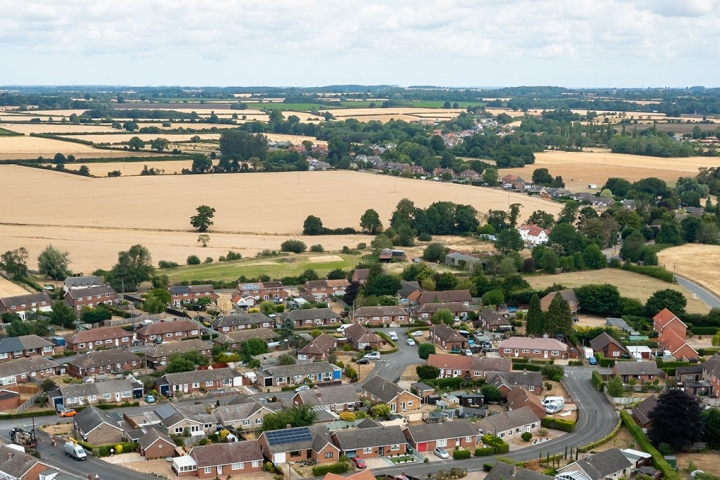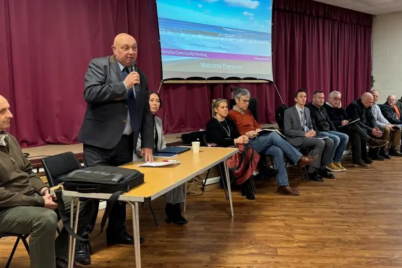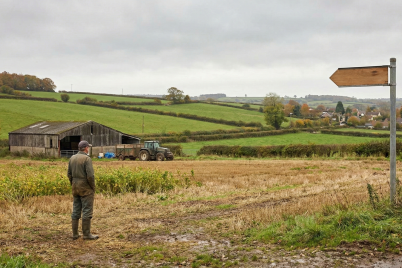Residents of Saham Toney, near Watton, are now better protected from flooding thanks to the completion of a major flood protection scheme led by the Norfolk Strategic Flood Alliance (NSFA). The initiative, which includes new flood storage basins and nature-based solutions, marks a turning point for the village after decades of recurring floods.
Saham Toney was identified as a priority area by the Norfolk Strategic Flood Alliance following repeated flooding over the past thirty years. By bringing together local government, water authorities, and drainage boards, the alliance coordinated a multi-agency response that delivered a 22,000m³ flood storage basin — completed ahead of schedule and under budget. The scheme includes two large storage basins located upstream of the village and 14 leaky dams, forming part of a wider flood alleviation programme that will continue for the next two years.
The £multi-agency project was jointly funded by Norfolk County Council, Anglian Water, and central government, and was constructed by the Norfolk Rivers Internal Drainage Board (IDB). But beyond the engineering, the project’s success has been driven by the cooperation and trust of local landowners who agreed to host flood infrastructure on their land.
Henry Cator, Chairman of the Norfolk Strategic Flood Alliance, praised the collective effort that made the scheme possible. “The scheme in Saham Toney is a testament to what can be achieved when we work together. NSFA’s role is to bring the right people to the table, and in this instance, collaboration has delivered real reassurance for residents. Sir David’s support has been key to providing this flood resilience scheme. We’ve seen projects that could have offered good levels of protection for communities fall through, because landowners weren’t willing to work with us.”
One such landowner, Sir David Ralli, whose land now hosts the first flood storage basin, reflected on his experience: “When I was first approached, I had concerns. But the team explained the long-term benefits clearly—not just for the village, but for the land itself. I’ve seen how these basins improve soil moisture and support wildlife. It’s a win-win. I’d encourage other landowners to get involved. The countryside needs us to step up.”
Capable of holding more than nine Olympic-sized swimming pools, the first basin will help safeguard over 30 homes in Saham Toney from the effects of extreme weather, including heavy rainfall and storms. The second basin, due to be constructed next spring, will be located on land owned by the Parish of Saham Toney.
The flood storage basins work by temporarily holding excess water during periods of heavy rain and releasing it slowly to prevent downstream flooding. This reduces pressure on known flood bottlenecks within the village and helps protect both homes and farmland.
Councillor James Bensly, Cabinet Member for Environment and Waste at Norfolk County Council, said: “This is one of the largest flood mitigation schemes ever delivered in Norfolk, and it’s a brilliant example of partnership working. Completing it ahead of schedule and under budget is a testament to the dedication of everyone involved.”
Beyond flood protection, the scheme also offers environmental benefits. The basins create new wetland habitats for amphibians and improve soil water retention, which will help support agriculture during dry spells. Phil Camamile, Chief Executive of Norfolk Rivers IDB, explained: “As the delivery partner and principal contractor, Norfolk Rivers IDB used clay sourced on-site to create new flood storage basins. By avoiding the need for imported materials, the project has reduced both costs and carbon footprint. It’s a great example of how smart engineering can deliver community resilience, environmental enhancement, and value for public investment.”
The project also incorporates sustainable drainage systems (SuDS) and rainwater harvesting measures to reduce surface water runoff from nearby housing estates, further increasing resilience to climate impacts.
Saham Toney, a civil parish in the Breckland district of Norfolk, is no stranger to challenging weather. The village, situated between Thetford and Norwich, has a long history stretching back to the Roman period, with evidence of early settlements nearby. Its name derives from the Old English for “homestead by the lake,” reflecting the 13-acre mere that has shaped local life for centuries.
Today, the village retains its historic charm with a flint-built parish church, St George’s, featuring a 15th-century tower and beautiful stained-glass windows. Saham Toney also has a thriving community centred around its local school, public house, and parish council. Former British Prime Minister John Major even spent time in the village during the Second World War when he was evacuated there as an infant.
Now, thanks to the Norfolk Strategic Flood Alliance, Saham Toney’s future looks more secure. The flood protection scheme not only safeguards homes but enhances the local landscape, supporting biodiversity and building community resilience. By combining engineering expertise, environmental care, and local cooperation, the NSFA has shown what can be achieved when people work together for a common good.
For the people of Saham Toney, who have endured years of uncertainty, the completion of the flood basins represents more than just infrastructure — it’s peace of mind. And for Norfolk as a whole, it stands as an inspiring example of how the Norfolk Strategic Flood Alliance is helping communities prepare for a changing climate while protecting the natural beauty and heritage that define the region.













